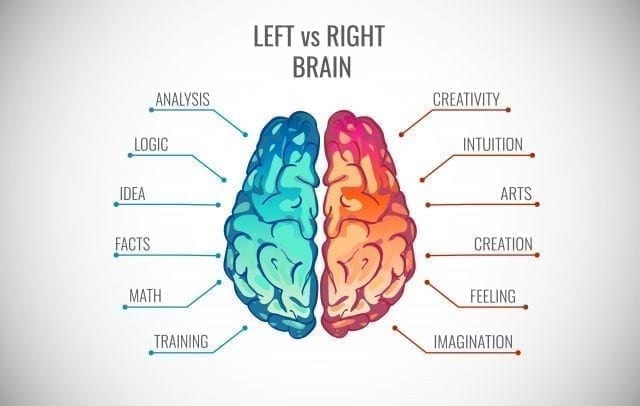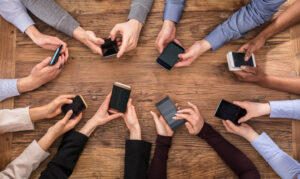
Left Brain, Right Brain: 9 Ways Our Brain Hemispheres Work Together
What are the functions of each brain hemisphere? What does each half of our brains do? Is it true that the left side is the analytic hemisphere and the right side the emotional side of the brain? Is it true that the ‘right brain’ is the creative one and the ‘left brain’ is the logical one? In this article, we will reveal everything you need to know about brain hemispheres.

We have often been told that the left hemisphere of the brain is the analytic, mathematical, and logical side, the side which is in charge of reasoning. You’ve probably also heard that the right hemisphere of the brain is the emotional, creative side.
In fact, people often use this difference as a way to define personality, referring to people as either left-brained or right-brained. “If you are a creative, sensitive, and passionate person, then you use your right hemisphere more; if you are an analytical, organized, and thoughtful person you use your left hemisphere more.” We hear that all the time, so let’s check some facts to see whether there is any truth to this common saying.
How the Two Hemispheres Work
How do the brain hemispheres work?
There is still a lot left to discover about brain hemispheres but here are some facts we do know:
- The brain is composed of two well-differentiated halves called hemispheres. These halves are connected by a structure called the corpus callosum, which facilitates communication between the hemispheres. These two hemispheres are in constant communication, and in most activities, both work equally.
- Experts suggest that our level of intelligence is directly related to the quality of the connection between hemispheres. The more connected they are, the more intellectual we will be, such is the example of Einstein’s brain.
- Each hemisphere is responsible for the activity on the opposite side of the body. That is, the right hemisphere will be responsible for the movements of the left side of the body and vice versa. Therefore, an injury to the left brain will have an impact on the right side of the body.
- The processing of visual and auditory stimuli, spatial manipulation, facial perception and artistic ability is found bilaterally, although they may show some superiority in the right hemisphere.
- Contrary to what was thought until recently, according to a study, the visual processing of numbers is performed by both hemispheres equally.
What Do The Two Sides of the Brain Do?
The Right Hemisphere of the Brain:
It deals, to a greater extent, with the following functions:
- The consciousness of oneself.
- Recognizing our image in a mirror.
- Facial recognition.
- Processing the emotional part of language, such as prosody and intonation.
- Feelings associated with intense romantic love.
- Managing visual-spatial attention.
The Left Hemisphere of the Brain
The left hemisphere of the brain is responsible for:
- Understanding and producing language.
- Mathematical abilities and recalling facts.
- Processing attractive faces.
In the next video, Ian Mcgilchrist explains why our brain is divided into two hemispheres, and what each one is responsible for.
The Two Hemispheres and Brain Lateralization
Brain lateralization is the idea that some brain functions rely more heavily on one hemisphere than on another. One example of this is when we process language. The left hemisphere is in charge of language processing for the most part, whereas the right hemisphere only processes verbal information in relation to emotion. However, it has recently been discovered that speech is processed in both hemispheres equally, so perhaps language is not as lateralized as we previously thought.
Likewise, it was believed that a left-handed person’s brain was less lateralized for language development. That is, it was believed that these people would use more of the right brain hemisphere for language, contrary to the general right-handed population. It has been proven that this only happens in 1% of the left-handed population.
It was even found that the degree of lateralization of some brain functions may vary from individual to individual.
Our brain is lateralized in some of its functions, however, most of these happen in both hemispheres. If a brain region or even a whole hemisphere is damaged or destroyed, other neighboring areas or even the opposite hemisphere may, in some cases, take over the activity typically performed by the damaged region. When brain damage interferes in the connections between one area and another, alternative connections can be developed to bridge the difficulties. This is only possible thanks to the brain’s great ability to adapt, which is called brain plasticity.
Brain Hemispheres: Do we use one more than the other?
A study from the University of Utah, USA, dismantled these myths:
There is no evidence that people use one of the brain hemispheres more than the other. This group of researchers identified brain networks in charge of process lateralized functions (brain functions that are processed more in one hemisphere than another), to see if it was true that some people used more one of the brain hemispheres more than the other.
During the study, the researchers analyzed the brains of 1,000 people and found that no individual was consistently using one hemisphere over another. They concluded that no personality type is related to the greater use of the left or right hemisphere.
Therefore, it is false that some people use one brain hemisphere more than another depending on their personality. Some functions may be specialized in a particular cerebral hemisphere, but the truth is that we use both hemispheres equally.
Some functions may be specific to a particular brain hemisphere; however, we use both brain hemispheres equally. Even though one hemisphere is specific for a function, it will always work better in continuous communication with the other hemisphere.Scientists can’t even establish that the right hemisphere is our creative brain. Creativity is a very complex process. According to a study, creative thinking does not seem to depend on a single mental process or brain region. Nor is it particularly associated with the right brain, attention, low level of activation, or synchronization with the alpha waves emitted by our brain.
Where Did the Myth of the Right Brain and the Left Brain Come From?
This myth arose from the misinterpretation of Roger Sperry’s experiments on divided brains. Studying the effects of epilepsy, Sperry found that cutting corpus callosum could reduce or eliminate epileptic seizures.
However, these patients also suffered other symptoms after communication channels between the brain hemispheres were severed. For example, many brain-split patients found themselves unable to name objects that were processed on the right side (those in the left visual field) but were able to name those processed on the left side (those in the right field of vision).
From this information, Sperry suggested that language was controlled exclusively by the left side of the brain.
We hoped you liked our article and please feel free to comment below.
This article is originally in Spanish written by Andrea García Cerdán, translated by Alejandra Salazar.












